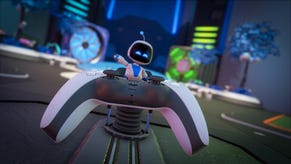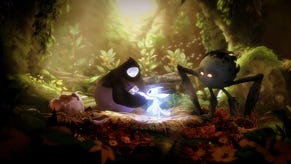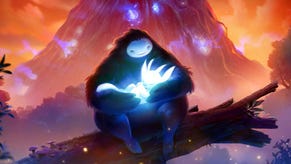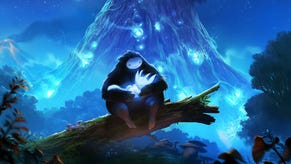Ori and the Blind Forest Review: Beauty is Cruelty
A feast for the eyes, a torture chamber for the soul. Microsoft's new metroidvania pulls no punches, but its fluid action and visuals make for the best anesthetic.
This article first appeared on USgamer, a partner publication of VG247. Some content, such as this article, has been migrated to VG247 for posterity after USgamer's closure - but it has not been edited or further vetted by the VG247 team.
When I first started writing about "metroidvania" games a decade ago, I did so because it was something of a dying artform and I feared its imminent demise. In a good year, we'd see maybe three or four new games in that style... and they were usually for portable platforms, deprecated by most of the industry as mere playthings rather than serious devices.
Much has changed since then, thanks largely to an influx of independent game designers who cut their teeth on Super Metroid and Castlevania: Symphony of the Night and said, "I want to make a game like that, too." And make them they have! This month alone sees the launch of three fairly notable metroidvania titles: La-Mulana EX, Axiom Verge, and Ori and the Blind Forest. That's more metroidvania games in one month than we saw for the entirety of 2009. Clearly, it's a format whose time has come — and, generally speaking, that's a good thing.
Yet the recent explosion of exploratory platformers has had its down side as well. When such creations were rare and precious, you could savor each one and not feel too critical of the frequent repetition of ideas from one game to another. Maybe games like Aliens: Infestation or Monster Tale weren't precisely brimming with originality and polish, but they were last bastions of a fading subgenre, notable simply for their existence.
Now that metroidvanias have essentially become a commodity, though, it's harder for each one to stand apart from its numerous competitors. And it's harder for players to overlook the fact that quite a lot of these games are simply coasting on the ideas of a classic from more than two decades ago.
Which brings us back to Ori and the Blind Forest, the latest in a growing line of non-linear exploratory platformers. Every Samus-come-lately these days tries to sell itself on the strength of some sort of unique hook, and Ori's particular feature is compelling at a mere glance: Quite simply, it is the single most gorgeous exploratory platformer ever made; one of the most beautiful games ever, in fact. Moon Studios' creation runs on 2D animation technology similar to the UbiArt Framework that powers Ubi games like Rayman Legends and Child of Light, but it makes them, and all those spectacular action RPGs by Vanillaware, look like mere sketches by comparison.
I could normally take or leave the 1080p/60fps obsession — a great game is a great game, and so long as framerate doesn't affect playability who really cares? — but this is one rare instance in which I just want to stop and soak up every last pixel on my screen. "Amazing" doesn't really do Ori's graphics and art direction justice; the entire game has been painstakingly hand-drawn from top to bottom, with special attention given to covering over the clumsy clichés of platform game world design. The rooms of Ori's map look like natural caves and grottos, with foreground elements (blurred by depth of field effects) obscuring the inelegant walls and obstructions that any other game would be content to present as an ant farm-like cutaway view. These obscuring visuals don't just make for a more visually consistent world, they enhance the game as well: Press the eponymous protagonist into a slightly suspicious niche in the wall and you just might stumble onto a hidden passage, revealed as the foreground camouflage fades into invisibility.
Ori made a tremendous impression at its first showing during last year's E3. Amidst the explosive violence and rage of Microsoft's press conference showing, this one game dared to be quiet, evoking a genuine swell of emotion with its wordless cartoon creatures. The standalone game itself doesn't have quite as much power as E3's stadium full of illuminated wristbands lighting up in sync with the glow of a mystic forest, but Ori's rambling woodlands nevertheless pull you in like few other games. It's so gorgeous, in fact, that you almost forget you've already done everything in Ori in a dozen other exploratory platformers.
Underneath its stunning visual patina, Ori and the Blind Forest takes its cues directly from the Metroid games. It's almost as faithful an imitation as Guacamelee. But where Guacamelee managed to overcome the predictability of its exploratory rhythms by integrating brawler mechanics into its non-linear action, Ori plays things straight, leaning almost entirely on the novelty of its visuals to compensate for the the rote nature of its power-ups and hidden passages. It quickly falls into a predictable pattern in which certain obstacles grow steadily more frequent until you acquire the new power-up needed to overcome that particular piece of the environmental puzzle, be it the ledges you double-jump to or the thin expanses of floor that you'll eventually smash with a power stomp.
The one shining exception to this rule comes in the form of Ori's skill tree, which allows you to unlock powers along three different specialization branches by gathering experience orbs from defeated enemies and special collectibles. You can see the full extent of the tree from the very beginning of the game, allowing you to plan ahead for your specialization. I focused primarily on navigational aids followed by defensive boosts, meaning that I had unlocked the ability to breathe infinitely underwater before I ever had the opportunity to swim; this allowed me to greatly simplify the swimming sequences by freeing me of the need to ration air, ever. Similarly, I unlocked the costly triple jump around the time the game went overboard with the chain-jumping sections, greatly reducing my frustration in some deviously designed areas of the middle game.
The skill tree allows you to customize Ori outside of the compulsory progression chain. While all of Ori's unlockable abilities are dependent on the powers you gather in the course of completing the adventure, the freedom to fine-tune them at your discretion lends a touch of customization for adapting the hero to fit your play style. Its RPG mechanics are by no means as involved as those of the latter-day Castlevania games, but the add-on abilities are both invaluable and intelligently implemented.
Thank goodness, because Ori and the Blind Forest is the kind of game that will leave you grateful for anything that mitigates its ferocious difficulty level. At its worst, it's the kind of game that has you clutching your controller in white-knuckled fury, holding on to it until the plastic creaks if only to bite back the impulse to throw the thing through the nearest wall. Ask anyone who's completed the game and they'll invariably seethe through clenched teeth about a certain upward race against a rapidly flooding screen; but while that sequence represents Ori at its absolute most hateful, it's hardly the only controller-snapping moment you'll encounter throughout the quest.
Ori's producers have been upfront and even boastful about their desire to create a game with a hardcore challenge, and they've certainly managed to accomplish that. While it may not be on the level of something like N+ or Super Meat Boy, it's also a different kind of game. The difficulty level reminds me quite a bit of Rayman Legends — and not in a good way. It's very much of the "gotcha" school of level design, full of blind jumps and traps whose mechanisms don't become clear until you've triggered them. It's about memorizing and trying again.
To Ori's credit, the designers offset its brutal difficulty with the freedom to save the game almost anywhere. With the right skills unlocked, you can lay down a respawn point every 30 seconds or so for very little cost, restoring several points of health in the process. Late in the game, you'll be dropping save points (Soul Links) after every nerve-wracking action sequence — an important habit to develop, because outside of manual saves Ori rarely backs up your progress, meaning a single cruel booby trap can wipe out tons of progress for anyone who hasn't been vigilant about generating Soul Links. If you're the sort of person who writes lengthy essays without ever bothering to save your word processing document, Ori and the Blind Forest will cure you of that tendency in a hurry.
The other problem with the Soul Link system is that it seems have enabled the designers to give into their nastiest tendencies, leaning on the assumption that players will be creating respawn drops at every turn, allowing them to fill the game world with all manner of cruel action sequences. While that sort of thing works well in small doses, it becomes downright oppressive in a game of this scale and scope.
And that's really the biggest shortcoming with Ori: It wants to be too many incompatible things all at once. It wants to be a grand metroidvania adventure, a stunning new gold standard for 2D game animation, and a harrowing act of platform game bastardry. It could be any two of these things in any combination easily enough, no problem. But all three? That's just asking too much, and it doesn't work as well as you might like.
The biggest incompatibility comes from the uneasy intersection between the visuals and the challenge level. Ori looks amazing, but as so often happens it achieves this level of graphical splendor at the expense of responsive play controls. The interface suffers from all sorts of annoying little quirks, like the fact that if you jump while standing near a vertical surface Ori will stick to it even if you're not pressing toward it or holding the climb button, making the fussy jump physics even more maddening. Some of the issues aren't even mechanical, just thoughtless aesthetic goofs; for example, Ori himself, a tiny white sprite, frequently disappears amidst all the glowing white screen effects at crucial moments.
At times, it seems Ori's creators forgot that this style of game invariably involves backtracking. While you spend plenty of time retracing your steps, the enemy spawns in many areas make for much harder navigation when doubling back than they did the first time through. A cardinal rule of this game style says that the trip back through conquered territory should be a breeze unless the game world undergoes some sort of metamorphosis to justify the boosted difficulty. That's not the case in Ori, but it doesn't feel like a deliberate choice — more like there wasn't enough consideration given to reverse navigation. The end result makes the act of navigating the world much more tedious than it should be. The radical difficulty spikes don't help, either. They can grind progress to a halt, reducing the action to a trial-and-error exercise in patience. This, too, undermines the joy of exploring the world as you find yourself smashed into a proverbial brick wall.
Despite all of this, you'll always find yourself crawling back to the game for another hit after storming away in a rage. It's not just that Ori is beautiful; holding all the derivative gameplay and sometimes sticky controls together is a fast, fluid action game. When you're not wrestling with Ori's controls, the game plays like a dream. This becomes especially true late in the adventure, where you have access to Ori's full range of commands and can string together a dozen different abilities to remain airborne indefinitely or destroy knots of bad guys without even using your standard attack.
It's a fickle, often frustrating game, but when it comes together, the action exhilarates just as the visuals stun. While I found myself cursing constantly at infuriating level design choices or weird control tics, Ori uses the familiar design language of games like Metroid to set a new standard for presentation, with mechanics that often feel as fluid as the graphics. Some of its more hostile design choices mesh poorly with the rest of the game, causing it to fall short of true classic status... but it's definitely one worth playing, if only to marvel at how great game animation can look.
VisualsA high-water mark for 2D graphics. At times, the world looks more like classic Disney cel animation than elements being manipulated by a graphics engine.
SoundAtmospheric, with music that dances around familiar melodies without being precisely derivative.
InterfaceOri can do a lot — a lot! — but I wish he did it less clumsily. The controls vacillate between spot-on and sloppy.
Lasting AppealToo frustrating to warrant a return trip, this world is still worth a visit. And I can't wait to see the inevitable no-death run on next year's AGDQ.
ConclusionWhile it stumbles over its own ambition far more than it should, Ori and the Blind Forest bursts with both detail and passion. At times it's less a game you play than one you force your way through despite your better judgment, but the parts where it all works together make it worth the pain. And wow, does it look good.










